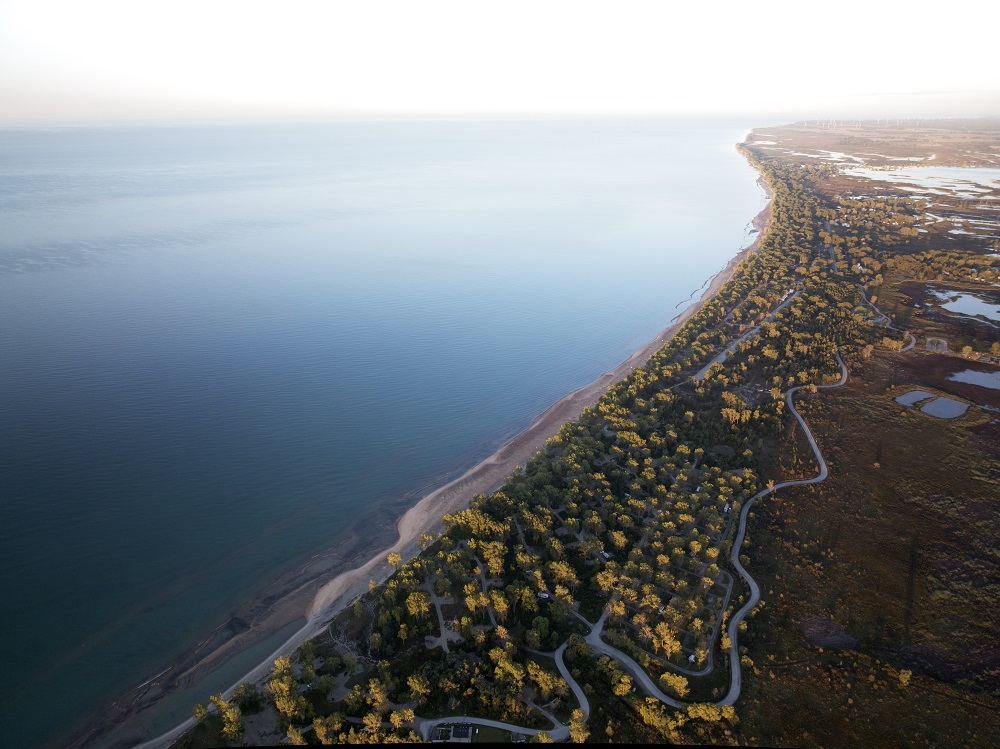In today’s blog, Discovery Project Program Coordinator Jessica Stillman reflects on our mutual relationship with the Great Lakes.
Our human history is reflected in their waters.
The Great Lakes capture our past, influence our present, and inspire our future.
Imagine the stories they could tell.
These bodies of water are called the Great Lakes for a reason: from their size (the largest surface freshwater system on Earth) to their role in our collective history, where do we even begin to share what makes them great?
Ontario Parks cares for approximately 2380 km of Great Lakes coastline, give or take 100 km since there are some parks which include many little islands, points, and narrow bays.

With many provincial parks along the Great Lakes to explore, how do we choose where to begin?
Exploring our past
The Great Lakes have connected us for thousands of years, but our relationships with their waters have varied.
For millennia, people have been travelling their waterways, seeking food from their depths, trading along their shores, and coming together at sacred sites.
Glimpses of these ongoing relationships can be seen at sites like the Pictographs at Lake Superior Provincial Park.

Travel, trade, food, and community changed significantly on the Great Lakes with the arrival of European settlers.
Colonization, settlement, and industry have all left their mark along the lakes’ shores and in their depths.

The lighthouses dotted across the shoreline, shipwrecks hidden below the surface, and recreational spots like provincial parks hugging the shorelines are visible reminders of the history of the Great Lakes.
But not all evidence of the changed relationships with water are visible or recognizable.
Living in our present
Consider what role the Great Lakes play in your life today.
From the places you visit to the food you eat and water you drink – they continue to connect us.
Your personal connection might be the memory of learning to swim in Lake Ontario, your first backcountry hiking trip along Lake Superior’s shoreline, or watching a perfect sunset over Lake Huron.

But our human connection to these waterways are also shadowed by over-harvesting, habitat loss, and poor water quality.
For example, together these impacts have been responsible for the decline of one of Ontario’s living dinosaurs: Lake Sturgeon.

The Great Lakes population of Canada’s largest freshwater fish is classified as a species at risk. In fact, our Lake Sturgeon, a species which survived mass extinctions events, are now facing imminent extinction in our Great Lakes.

When we’re not mindful, our connection can threaten the balance of crucial natural resources. We need to ensure our relationship with the Great Lakes is healthy and sustainable.
To plan for the future of the Great Lakes we must work together to understand the relationships bound to their waters, both as a society and as individuals.
Looking to our future
The Great Lakes are the largest freshwater system in the world and home to over 4,000 species.
Along the shorelines and in the water, species (common and rare) add to the beauty, mystery, and wonder of each lake.

Our actions have left marks, some more visible than others, but all lasting.
Local communities, Indigenous peoples, and provincial parks collaborate to protect the collective heritage and ecological integrity of the Great Lakes.
To keep their turbulent, ever-evolving stories alive, we all must work together.
Here’s how you can help us protect the Great Lakes:
- when you visit, leave no trace! Take only pictures, leave only footprints
- contribute to community science by joining iNaturalist
- learn more about the Great Lakes through Discovery programming
- join efforts to clean up local beaches and shorelines
Let’s work together to protect, preserve, and maintain the greatness found right in our own backyards, the Great Lakes.

A beautiful ecosystem reflecting our past, present, and future in its waters.
A picture is worth a thousand words
Spread the Great Lakes love and share your pictures with us on Facebook, Instagram, and Twitter.
